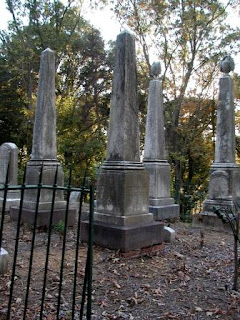The purpose of my visit, however, was not strictly archaeological. Scott and I went there to assess the condition of the Hanson-Fergusson cemetery with an eye toward helping the current owner, Mr. Ed Edelen, restore it. We also share Mr. Edelen's interest in learning the fate of the mortal remains of John Hanson, the first President of the United States of America under the Articles of Confederation (1781-1782), before the adoption of our present constitution.

John Hanson was born at Mulberry Grove in either 1715 or 1721 (we are not sure). Although he resided in Frederick County at the time of his death, he met his end at his nephew's home at Oxon Hill, Prince George's County, in 1783. He is reputed to have been buried at Oxon Hill, but there is no monument marking his grave there, in Frederick, or at Mulberry Grove. His wife Jane (nee Contee), however, was buried at Mulberry Grove upon her death in 1812, as are two of their infant children. Each of those three graves is marked by a ledger stone (a large, flat piece of marble placed horizontally on a brick foundation), and there is a space between Jane's monument and those of her two children. Furthermore, there is a depression in that space. Had someone dug a hole looking for a grave? or is the depression a grave, possibly that of John Hanson?
Scott and I are considering ways in which we can determine whether this is a grave without actually disturbing the grave. We also are considering measures to repair and plumb the rest of the monuments that mark the graves of Mulberry Grove's occupants. (Scott is certified in the repair of marble monuments and the two of us have worked on the documentation and restoration of several cemeteries in Maryland and Delaware.) While the search for John Hanson has its own particular interests and challenges, the search for cemeteries in the area will not end there. We know there is at least one cemetery at Port Tobacco buried beneath the silt, and I suspect there are others, and there are likely others at neighboring plantations. We are hoping to receive a grant that will allow us to purchase some of the advanced technologies that will improve our ability to locate and define cemeteries without necessarily excavating them. Keep fingers crossed.
Jim
















2 comments:
I believe former President John Hanson was interred at the Gloria Dei church in Philadelphia, PA.
The Gloria Dei is a marker to early Swedish-Americans, however he is not buried in Philadelphia.
Wade Compton told Robert Barbour that he remembered seeing the grave in the swamp while duck hunting in 1919.He remembered it as a table stone grave.
Best wishes
Post a Comment